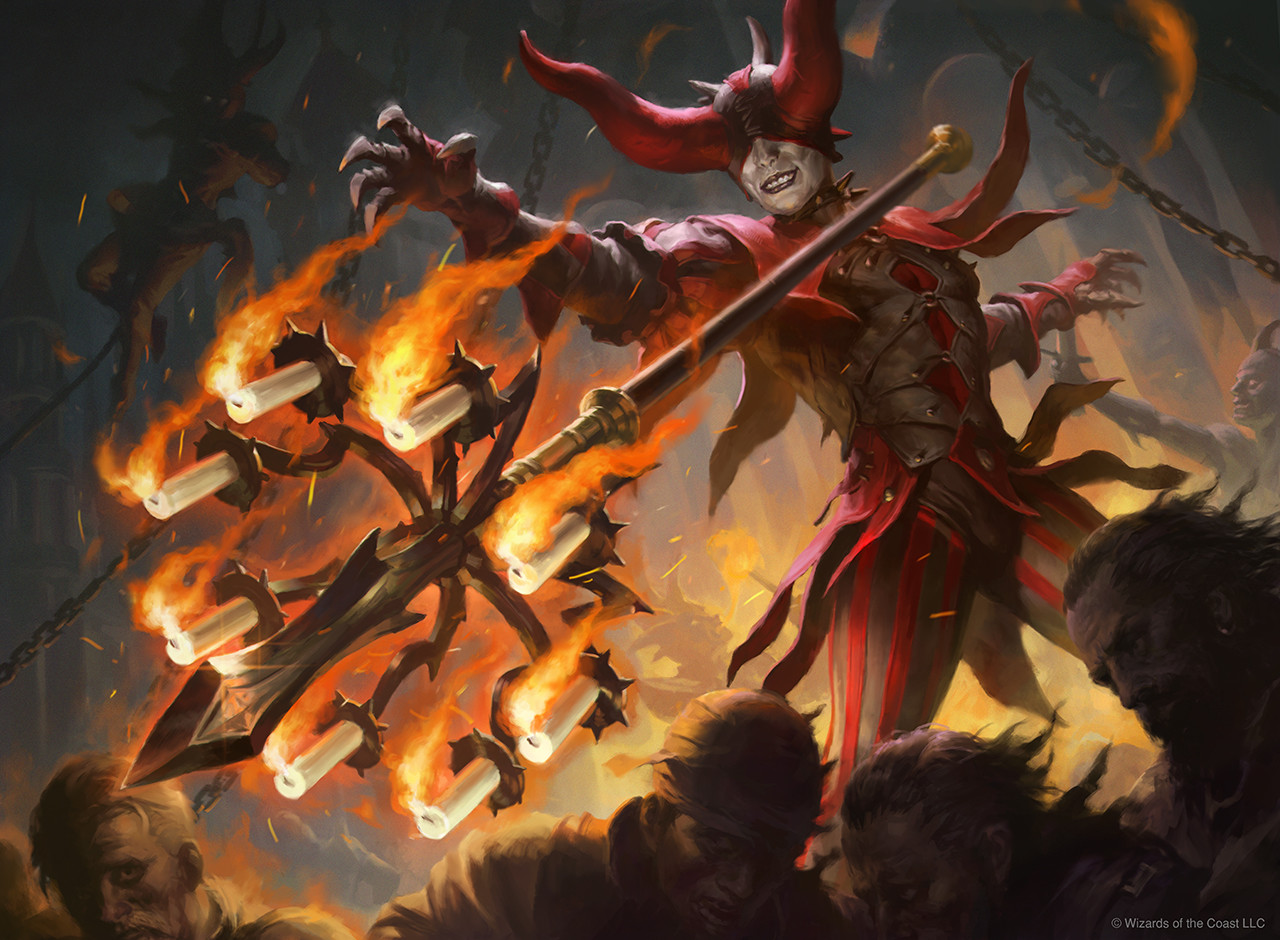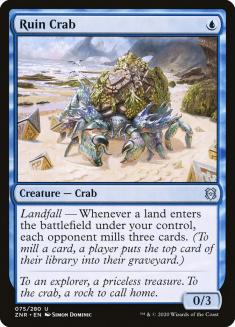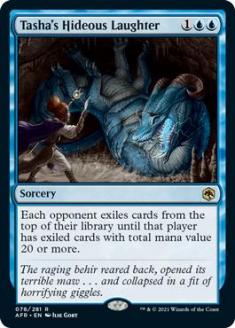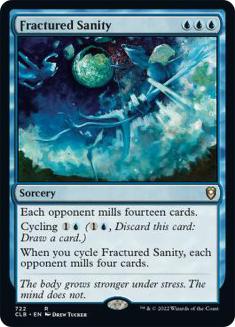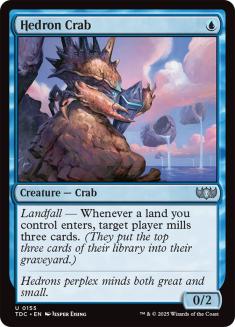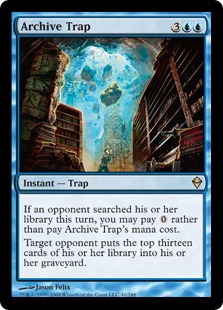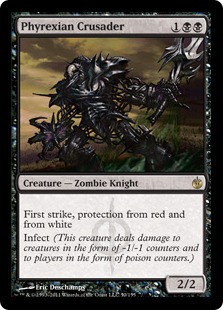As wonderful as it is to see the Modern metagame since Modern Horizons 2 continue to change week to week, the script it’s following is rather predictable. We had the typically turbulent opening weeks of Magic as players tried anything they found interesting, and powerful new cards that found a home quickly got all the hype — in this case it was Urza’s Saga.
This was followed by the establishment of the first archetypes that would set an established metagame rather than just fade away once the tricks were figured out — in this case the fair Ragavan, Nimble Pilferer and Dragon’s Rage Channeler decks. These midrange decks were both powerful and flexible, which allowed them to adapt with the dynamic metagame. They were initially attacked by Mono-White Hammer (Lurrus), but were able to figure out the matchup without much struggle.
Eventually, the midrange decks started adapting to beat each other, leading to a classic arms race where the midrange decks slowed down and incorporated more card advantage to win the attrition-oriented midrange mirrors. Eventually, that arms race leads to a potential exploit by decks that focus entirely on going over the top of their opponents, most exemplified recently by the return of Mono-Green Tron.
Last weekend, we saw the next step in the evolution of the Modern metagame, and that’s a return of linear decks that go underneath Mono-Green Tron and friends while having enough resilience to also capitalize on midrange decks that are still inbred to beat other midrange decks. The results show a multitude of such linear decks, and it’s unclear exactly which ones will disappear quickly and which will stick around to some extent.
I’ve looked deeply at each deck, and based on its raw power and ability to adapt moving forward, I will decide whether I’m buying it as a future player in Modern, or sell it as a worse option that will struggle to find consistent success moving forward. Note that I’m focusing on archetypes that are currently on the rise, rather than established linear decks like Living End and Mono-White Hammer.
Buy: Boros Burn (Lurrus)
Creatures (12)
Lands (20)
Spells (28)

This is the most successful of the six decks I’ll be covering today, and is an easy buy. With the influx of powerful cards in Modern Horizons 2, decks are better at interacting with the battlefield than ever before. And the simplest way to not play that game is to focus entirely on the life total axis.
Moreover, the most important qualities to have as a linear deck to beat big decks like Mono-Green Tron are speed and consistency, and Boros Burn (Lurrus) has that. It’s not the fastest deck around, but it’s fast enough to race and incredibly consistent due to shear redundancy.
There haven’t been any major additions to Burn in recent years, but filling out the list with Skewer the Critics and having a significantly better mana base with Inspiring Vantage and Horizon Lands all serve to add a few percentage points across the board. And Lurrus of the Dream-Den, which to my ongoing astonishment many Burn players still haven’t adopted, adds a level of insurance against mana flood that Burn desperately wants.
Burn isn’t the most adaptable deck, but fortunately it’s quite difficult to gameplan against it with direct hate cards because the metagame is too wide. Any deck with a combination of removal, discard/counterspells, and pressure will be at least competitive against Burn, so there isn’t much incentive to go out of your way to solidify the matchup when there’s so many other things to worry about. So I don’t anticipate a huge uptick in Kor Firewalkers, Timely Reinforcements, and Dragon’s Claws unless Burn becomes much more popular.
Lastly, I like Burn because it’s a surprisingly difficult deck to play well. Despite its reputation as simple and straightforward, there’s plenty of intricate lines you need to make with Burn to give yourself the best odds to win, especially when playing around various pieces of disruption your opponents can have. Whether it’s holding your burn spells in the face of counterspells to set up one big turn where your opponent runs out of mana, or knowing when to Lightning Bolt an opposing creature and when to go upstairs and hope your deck serves up the rest, Burn presents a number of tricky plays and nuanced decisions to make, and the best players of the archetype will see it reflected in their win percentage.
This ability to outplay your opponent is often less prevalent in linear decks, and gives Burn a real advantage when picking between them.
Sell: Selesnya Hexproof (Lurrus)
Creatures (12)
Lands (20)
Spells (28)

Ever since Reid Duke took Slippery Bogle to the finals of the World Championship, Selesnya Hexproof has regularly popped up as a potential metagame choice at various points in Modern’s history. It was a deck players looked to to answer the Eldrazi Menace during Eldrazi Winter, as well an answer to Dredge when it was dominating the format. But in every case, the deck has ultimately fallen short, and I don’t see that changing any time soon.
The general problem that this deck has each time it looks like it might be good again is that it’s just not very consistent. Even with the London Mulligan rule, having only eight hexproof creatures leads to an incredibly high fail rate. And with how much removal there is nowadays, your backup plans of Kor Spiritdancer and Dryad Arbor aren’t working nearly as often. Lurrus may be the best card in all of Modern, and it certainly helps on this axis, but you can gain the powerful companion in a number of other decks.
Beyond the difficulty in consistently finding a hexproof creature, this deck also needs the right assemblage of Auras to win games. In some matchups you need to race with Ethereal Armor and All That Glitters, in others you need the resilience from Umbras, and in others you need the Rancors and Daybreak Coronets to make sure you can break through wide battlefields. Infect gets evasion from some of its threats, and Mono-White Hammer can tutor for its one Shadowspear with Urza’s Saga, but Selesnya Hexproof is dependent on its deck to find the right pieces, and that just doesn’t cut it in 2021.
More specifically, Selesnya Hexproof doesn’t match up well against Mono-Green Tron, the number one big deck that these linear archetypes are trying to beat. Oblivion Stone, Ugin, the Spirit Dragon, and All Is Dust are all nightmares for Auras, and Karn Liberated and Wurmcoil Engine can also be quite powerful on the right battlefield. I wouldn’t touch this deck until it gets some major upgrades from future sets, because right now it’s a relic of a bygone era.
Buy: Dimir Mill (Lurrus)
Creatures (8)
Lands (22)
Spells (30)

Dimir Mill (Lurrus) has been rising and falling over the last month and change, which has given it the reputation of a deck that depends on taking a metagame by surprise, but I think it’s better than that. A fringe deck for years, the main engine of the deck is finally complete, by which I mean filled with only quality cards for its plan with Ruin Crab, Tasha’s Hideous Laughter, and Fractured Sanity joining longtime standouts Hedron Crab and Archive Trap.
That sets Dimir Mill at a competitive baseline for Modern play, which is important for any deck that wants to be more than a one-weekend wonder. It means there’s a chance to compete even when you’re being targeted by the metagame. Beyond that baseline though, you need to be adaptable, so that you can begin to react to how the rest of the metagame is targeting you and find ways to circumvent the hate.
Dimir Mill has that adaptability, in part because it doesn’t have to devote as many slots to actual mill cards. Fatal Push, Drown in the Loch, Surgical Extraction, and Crypt Incursion all let you interact to some extent, and while the graveyard hate is necessary to stop Eldrazi and other cards that shuffle the opponent’s graveyard into their library, there are metagames where you can trim on them in order to fit other, more relevant pieces of interaction.
Having so many slots available for interaction also makes your sideboard much more effective, which lets you make minor tweaks by playing narrowly powerful cards like Mystical Dispute, Ceremonious Rejection, or even Ensnaring Bridge. Linear decks historically have poor sideboards because they can’t bring in many cards lest they disrupt their core engine, but Dimir MIll functions more like a hybrid control-combo deck in some matchups, and that makes it a lot more flexible.
If you’re able to stay ahead of the metagame with smart sideboard choices and appropriate maindeck changes, then I have no doubt that you can have consistent success with Dimir Mill.
Sell: Selesnya Company
Creatures (30)
- 4 Spike Feeder
- 4 Auriok Champion
- 4 Arbor Elf
- 2 Walking Ballista
- 4 Ranger-Captain of Eos
- 4 Heliod, Sun-Crowned
- 4 Conclave Mentor
- 4 Skyclave Apparition
Lands (22)
Spells (8)
Sideboard

Six months ago, Selesnya Company was the best deck in Modern. But it’s a new world now, and this deck isn’t bringing anything new to the table. Eventually even the red decks that Heliod beats on paper found ways to turn the matchup around, and that was in a time when Heliod, Sun-Crowned was nearly impossible to remove from the battlefield. Now you have Prismatic Ending everywhere, making it much less safe to run out an early Heliod that would make it very risky for your opponent to tap out.
Historically, creature-combo decks with Collected Company, like Birthing Pod before it, were able to grind through removal and win games in the red zone, which made it difficult for opponents to overload their sideboards to beat whatever combos you had. But as the format has grown in size and power level, it’s gotten harder and harder to win games with motley crews of undersized creatures. Ranger-Captain of Eos isn’t scaring anyone unless it’s finding Death’s Shadow.
The best plan to create a big attack is to turn on Heliod as a creature, which on paper looks quite doable with Ranger-Captain of Eos, Auriok Champion, and Skyclave Apparition, but in reality, if you have a battlefield with multiple of those creatures and a Heliod, you’re probably combo-ing or about to because your opponent clearly isn’t interacting all that much.
The aggro plan in these decks needs to be one that comes together when you’re relatively light on resources, because it’s supposed to win games after your opponent interacts many times. Attacking with a God based on your devotion is the exact opposite of that situation. It’s nice to play the lifegain deck when Burn is experiencing a resurgence, but that’s about the only good thing going for Heliod right now, and Burn would have to be way more popular for that one variable to be compelling enough for me to sleeve this one up.
Buy: Hardened Scales
Creatures (23)
- 4 Arcbound Ravager
- 1 Arcbound Worker
- 4 Hangarback Walker
- 4 Walking Ballista
- 4 Zabaz, the Glimmerwasp
- 3 Esper Sentinel
- 3 Ingenious Smith
Lands (24)
Spells (13)

I still remember seeing Dom Harvey’s winning list of Mono-Green Hardened Scales from an early Challenge after MH2, which he wrote about here:
I was impressed by the deck then, and fully expected it to bring Arcbound Ravager back into Modern, but it soon fell into obscurity. Now it’s back and significantly improved with the additions from white all adding much-needed resilience to a deck that is surprisingly easy to interact with since Prismatic Ending, Kolaghan’s Command, Prismari Command, and Engineered Explosives all answer artifacts and/or enchantments.
The trio of Esper Sentinel, Ingenious Smith, and Lurrus are all found in Mono-White Hammer, perhaps the most successful linear deck in Modern right now, and they certainly help out quite a bit here in assembling this deck’s powerful synergies. So the current lists should be much better equipped to win against the various red midrange decks and their piles of removal.
The other reason I like this deck is that it also uses its sideboard quite well. Urza’s Saga lets you bring in interactive artifacts like Grafdigger’s Cage and Pithing Needle and find them consistently, offering a little bit of additional interaction to supplement the powerful Walking Ballista in creature matchups.
Without Mox Opal, this deck’s glut of two-drops means it’s not the fastest linear deck out there, but it can certainly overpower the Mono-Green Tron opponents of the world, and various sources of card advantage mean that like Mono-White Hammer, it can win through a surprising amount of interaction. Add in the touches of interaction it can play and I think there’s something here.
Sell: Golgari Infect
Creatures (16)
Lands (21)
Spells (23)
- 4 Might of Old Krosa
- 3 Thoughtseize
- 4 Vines of Vastwood
- 2 Groundswell
- 1 Become Immense
- 3 Fatal Push
- 3 Scale Up
- 3 Wild Shape
Sideboard

This is the deck I went back and forth on the most, because I do think it has some potential, but ultimately I think too much of that potential is invested in the power of Phyrexian Crusader.
Infect has fallen off hard as the rest of the format has become more mana efficient, because that was secretly the axis that Infect fought on. The curve of Noble Hierarch into Blighted Agent with one mana left up for Vines of Vastwood is very difficult to interact with unless your curve is very low. But if you do manage to clean up their threats, the leftovers of Apostle’s Blessing, Groundswell, Mutagenic Growth aren’t scary in the least. This metagame produces a lot more of the latter than before.
But Phyrexian Crusader is an absolute game changer in any matchup without Fatal Push, and there are very few Fatal Pushes around (fewer than at any point I can remember since the card was printed). Goglari Infect first emerged in the pre-Fatal Push era for the same reason — Phyrexian Crusader was nearly unkillable. But that version of the deck had much worse mana without access to Blooming Marsh, Nurturing Peatland, and Ignoble Hierarch.
Phyrexian Crusader is now much more easily castable than it used to be, and nearly as unkillable, but how often is this deck winning games when it doesn’t land an early Crusader? Sure, you can race Moon-Green Tron and the like, or catch your opponents with a removal-light draw, but I don’t like depending on those things, especially in an era with more open decklist tournaments than ever before.
I’d say that if you’re good enough with Infect to navigate through a lot of difficult games, picking up this version has some merit, but I wouldn’t put in the effort to learn it from nothing, since I think you can do at least as well if not better with other options.
With linear archetypes as well as control decks emerging, the complete Modern metagame is taking shape. And while I think Ragavan and Dragon’s Rage Channeler are overrepresented, the metagame is still diverse, dynamic, and interesting.
And that’s all I can really ask for.

